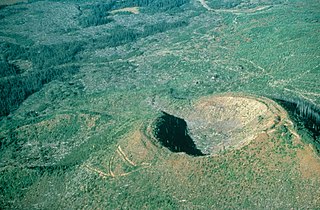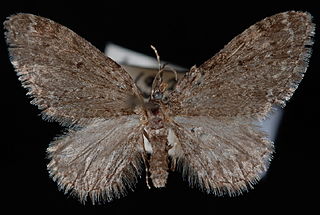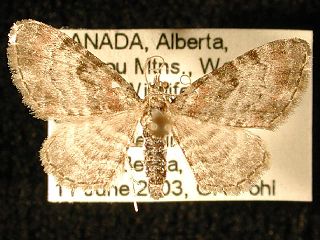
Jack pine is an eastern North American pine. Its native range in Canada is east of the Rocky Mountains from the Mackenzie River in the Northwest Territories to Cape Breton Island in Nova Scotia, and the north-central and northeast of the United States from Minnesota to Maine, with the southernmost part of the range just into northwest Indiana and northwest Pennsylvania. It is also known as grey pine and scrub pine.

The Thompson River is the largest tributary of the Fraser River, flowing through the south-central portion of British Columbia, Canada. The Thompson River has two main branches, the South Thompson River and the North Thompson River. The river is home to several varieties of Pacific salmon and trout. The area's geological history was heavily influenced by glaciation, and the several large glacial lakes have filled the river valley over the last 12,000 years. Archaeological evidence shows human habitation in the watershed dating back at least 8,300 years. The Thompson was named by Fraser River explorer, Simon Fraser, in honour of his friend, Columbia Basin explorer David Thompson. Recreational use of the river includes whitewater rafting and angling.

The North Thompson River is the northern branch of the Thompson River, the largest tributary of the Fraser River, in the Canadian province of British Columbia. It originates at the toe of the Thompson Glacier in the Premier Range of the Cariboo Mountains, west of the community of Valemount. The river flows generally south through the Shuswap Highland towards Kamloops where it joins the South Thompson River to form the main stem Thompson River.

The Flourmill Volcanoes, also known as The Flourmills, are a small volcano range near the west boundary of Wells Gray Provincial Park in east-central British Columbia, Canada. Located north of Mahood Lake and west of the Clearwater River, they form part of the Wells Gray-Clearwater volcanic field.

Dasychira grisefacta is a species of moth of the family Erebidae. It is found in Alberta, from British Columbia to Arizona and Oregon, in New Mexico, Montana, South Dakota and North Dakota.
Syngrapha abstrusa, the abstruse false looper, is a moth of the family Noctuidae. It is found from Newfoundland to New Jersey, Southern Canada, Montana and Northern New Mexico.
Xenotemna is a genus of moths belonging to the family Tortricidae. It contains only one species, Xenotemna pallorana, which is found in North America, where it has been recorded from Alaska to California, east to Florida and north to Quebec and Ontario.

The Cascade Mountains leeward forests are a temperate coniferous forest ecoregion of North America, as defined by the World Wildlife Fund (WWF) categorization system.

The Alberta-British Columbia foothills forests are a temperate coniferous forests ecoregion of Canada. This ecoregion borders Canada's taiga and contains a mix of subarctic forest and temperate forest species as a result. This makes the region an ecotone region, or a region that acts as a buffer between two other biomes.
The Midwestern Canadian Shield forests ecoregion, in the Taiga and Boreal forests Biome, are of northern Canada.
Ypsolopha dentiferella is a moth of the family Ypsolophidae. It is found throughout North America. In Canada, it occurs in most provinces, being most frequently collected in British Columbia and Alberta. It is known from a wide variety of habitats, including mixed wood forests, semi-arid scrubland, prairies and badlands.

Callophrys niphon, the eastern pine elfin, is a species of Lycaenidae that is native to North America.

Retinia albicapitana, the northern pitch twig moth, is a moth of the Tortricidae family. In Canada it is found from Nova Scotia to British Columbia and north probably into the southern parts of the Northwest Territories. In the United States, it extends as far south as Montana and the Great Lakes states.
Leymus innovatus is a species of grass known by the common names downy ryegrass, boreal wildrye, hairy wildrye, fuzzyspike wildrye, northern wildrye, and northwestern wildrye. It is native to northern North America from Alaska to eastern Canada and south to South Dakota.

Eupithecia placidata is a moth in the Geometridae family. It is found from British Columbia south to California.

Eupithecia annulata, the larch pug moth, is a moth in the family Geometridae. The species was first described by George Duryea Hulst in 1896. It is found in North America from British Columbia north to the Yukon, east to Newfoundland and Labrador and south to California and Colorado.

Eupithecia albicapitata is a moth in the family Geometridae. It is found from Newfoundland and Labrador to western British Columbia, north to Alaska and Alberta, south to New England and New York.

Amorbia humerosana, the white-lined leafroller, is a species of moth of the family Tortricidae. It is found from the Gulf states to the northeastern United States and southeastern Canada.
Argyrotaenia tabulana, the jack pine tube moth or lodgepole needletier moth, is a species of moth of the Tortricidae family. It is found in North America, where it has been recorded from Alabama, Arkansas, British Columbia, Florida, Georgia, Indiana, Louisiana, Maine, Maryland, Massachusetts, Mississippi, New Jersey, New York, North Carolina, Ohio, Oklahoma, Pennsylvania, South Carolina and West Virginia.
Clepsis persicana, the white triangle tortrix or the green needleworm, is a species of moth of the family Tortricidae. It is found in North America, where it has been recorded from Alaska and British Columbia to Newfoundland and south to Virginia and west to California. The habitat consists of coniferous and mixed coniferous forests.



















